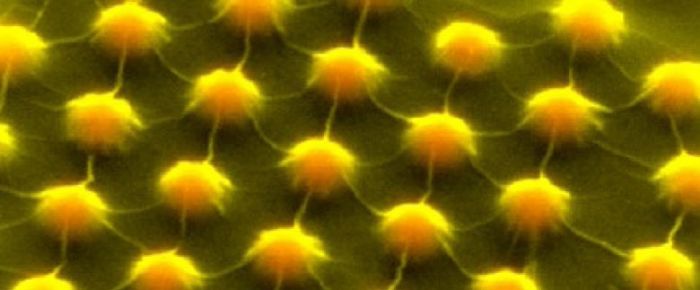 Colorized image, enlarged 100,000 times, shows an ultrathin layer of molybdenum disulfide stretched over the peaks and valleys of part of an electronic device.
Colorized image, enlarged 100,000 times, shows an ultrathin layer of molybdenum disulfide stretched over the peaks and valleys of part of an electronic device.
- Written by Stanford News
Stanford researchers stretch a thin crystal to get better solar cells
Solar cells may be a solution to global energy needs. Stanford News reports on a collaboration of mechanical engineering and physics researchers achieving an innovative crystalline solar cell with a variable band gap that can be set by stretching the lattice. This variable semiconductor could lead to solar cells that absorb more energy from the sun by being sensitive to a broader spectrum of light.
Their paper in Nature Communications describes how Stanford mechanical engineer Xiaolin Zheng and physicist Hari Manoharan proved that MoS2 has some useful and unique electronic properties that derive from how this crystal forms its lattice.
Molybdenum disulfide is what scientists call a monolayer: A molybdenum atom links to two sulfurs in a triangular lattice that repeats sideways like a sheet of paper. The rock found in nature consists of many such monolayers stacked like a ream of paper. Each MoS2 monolayer has semiconductor potential.
"From a mechanical engineering standpoint, monolayer MoS2 is fascinating because its lattice can be greatly stretched without breaking," Zheng said.
By stretching the lattice, the Stanford researchers were able to shift the atoms in the monolayer. Those shifts changed the energy required to move electrons. Stretching the monolayer made MoS2 something new to science and potentially useful in electronics: an artificial crystal with a variable band gap.
"With a single, atomically thin semiconductor material we can get a wide range of band gaps," Manoharan said. "We think this will have broad ramifications in sensing, solar power and other electronics."
Read the full article at Stanford News.
Visible Legacy Comment
The Stanford Zheng group studies the interfacial science among combustion, nanomaterials and energy conversion. They are recently working toward high-dimensional nanomaterials to provide innovative and revolutionary solutions to solve some of today’s most challenging problems, such as energy and the environment. The Zheng group is also interested in innovating new manufacture methods for flexible and attachable inorganic electronics. See the latest research from the Xheng Laboratory by exploring the map below!
updated 161003.1
Additional Info
-
Navigator:
 Explore the map in Navigator
Explore the map in Navigator - Widget:
- Caption: The Zhang group is in the Stanford Department of Mechanical Engineering
Related items
- The future of health care is in our cells
- Federal funding will help WSU professor develop technology to recover rare earth elements
- Unlocking the brain: Peptide-guided nanoparticles deliver mRNA to neurons
- Scientists Get to the Bottom of COVID’s Worst Pediatric Complication
- WSU-inspired national gene-editing task force begins work
